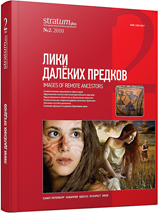Пустой дольмен: утрата источника или норма погребальной практики
Emptiness of Dolmens: Lost Source or a Norm of Burial Practice
Author(s): Aleksandr M. SmirnovSubject(s): History, Archaeology, Cultural history, History of Religion
Published by: Издательский дом Stratum, Университет «Высшая антропологическая школа»
Keywords: dolmen; megalith; temple; female deity; Mesopotamia; grille-like structure; birth
Summary/Abstract: In the Western Caucasus, the number of dolmens is counted as many as some thousand pieces. Most of them were discovered without any remnants of original burial contents. Massiveness of these constructions, openness for access from outside together with absence of any traces of burials survived inside — all this forced scholars to conclude the dolmens were erected as collective tombs and were plundered afterwards. But all these suppositions strongly contradict with the specifics of their construction — the portholes are placed in them too low to serve as entrances for collective tombs; then, there is absolute absence of any human bones outside dolmens that might be thrown away by hypothetical robbers. Now, I put forward the idea of the successive replacement of burials into dolmens. Moreover, instead of the idea of collective tomb which in the end of their functioning was filled possibly up its capstone, I prove that dolmen must be empty as the final result of its functioning. This paper is based on comparison of certain compositions in the megalithic art of Europe with corresponding images in the art of Ancient Near East. As to megalithic tombs, it deals with two compositional patterns, one of which includes a female deity or her attributes and a grille-like structure; the other one — pairs of ungulates and grille-figures. The latter has direct analogies in glyptic of Mesopotamia. These are scenes with pairs of ungulates standing before reed (hence grille-looking) stalls, which are the temples of the goddess Nintur, the deity of childbirth. These compositions are representations of giving birth to posterity where the temple itself acts as ‘uterus’ bringing newborn animals into the world, being not a living thing at the same time. Similar scenes engraved in megalithic tombs, like representations of female deities and grille-structures figured there, perhaps witness possession by these burial constructions of the same temple functions. So, as a result, in the periods of time when the process of inhumation and following birth-giving was not put into effect, these huge monuments were empty, imitating thus the same condition of ‘uterus’ between recurrent pregnancies. So, such funeral ideology of dolmens demonstrates actual realization of the idea shared widely both in antiquity and in recent time that “which thou sowest is not quickened, except it die” (I Cor: 15, 36).
Journal: Stratum plus. Археология и культурная антропология
- Issue Year: 2010
- Issue No: 2
- Page Range: 169-184
- Page Count: 16
- Language: Russian

